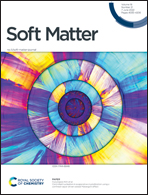Improved mechanical properties of antimicrobial poly(N-[3-(dimethylaminopropyl)] methacrylamide) hydrogels prepared by free radical polymerization in the presence of cetyltrimethylammonium bromide as a lyotropic liquid crystal template
Abstract
The poor mechanical strength of the poly(N-[3-(dimethylamino)propyl] methacrylamide) (PDMAPMAAm) hydrogel limits its application as a drug delivery system and antimicrobial agent. In this study, both its morphology and antibacterial effectiveness were controlled through free radical solution polymerization in the presence of cetyltrimethylammonium bromide (CTAB; cationic nonreactive surfactant), forming lyotropic liquid crystal (LLC) mesophases. All the templated reactions proceeded in four different CTAB concentrations with three different concentrations of DMAPMAAm (2.0, 3.0 and 4.0 mol L−1), which were carried out in distilled-deionized water (DDW) using potassium persulfate (KPS) and N,N′-methylenebisacrylamide (BIS) as the initiator and crosslinker, respectively. The pH-dependent phase transition temperature (34 °C at pH 14), compression moduli, antibacterial and diffusion properties, and the effect of the LLC mesophases of CTAB on the hydrogel properties were investigated by mechanical measurements, image analysis, inhibition zone tests, X-ray diffractograms and polarized optical microscopy (POM). It was found that the compression moduli of the templated (T)-PDMAPMAAm hydrogels increased by nearly ten times (from ∼3.0 to 30.0 kPa) compared to that of the isotropic (I) ones. The POM and XRD results before the removal of CTAB exhibited the formation of lamellar and hexagonal mesophases. Further, the inhibition zones showed the ability of the I-PDMAPMAAm hydrogels to reduce the activity of E. coli even in the absence of CTAB, gentamicin (GS) and ciprofloxacin (CF). This was because the quaternary ammonium (QA) groups on the DMAPMAAm units could interact with the bacterial membrane.
![Graphical abstract: Improved mechanical properties of antimicrobial poly(N-[3-(dimethylaminopropyl)] methacrylamide) hydrogels prepared by free radical polymerization in the presence of cetyltrimethylammonium bromide as a lyotropic liquid crystal template](/en/Image/Get?imageInfo.ImageType=GA&imageInfo.ImageIdentifier.ManuscriptID=D2SM00186A&imageInfo.ImageIdentifier.Year=2022)


 Please wait while we load your content...
Please wait while we load your content...